Physiological Functions of the Six Yang Organs
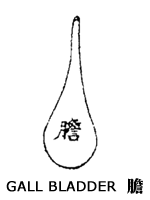 Gall Bladder Gall Bladder
Similar to western medicine, in TCM the gall bladder stores and secretes bile produced by the liver. The liver's flowing and spreading properties allow bile to be secreted into the small intestines where it aids the digestive process. Liver harmony is essential for the healthy functioning of the gall bladder. The secretion of bile also supports the spleen in its transformation functions. If liver disharmony occurs, bile secretion is affected, which can have a negative impact on other digestive functions. Disharmony of gall bladder function leads to jaundice where an individual develops yellow eyes and yellow skin colour as a result of a build up of bile in the body.
In TCM, the gall bladder rules decision and is related to bravery.. Mental disorders involving anxiety and fear are treated by resuming gall bladder harmony.
Click here to read more about the Gall Bladder Meridian.
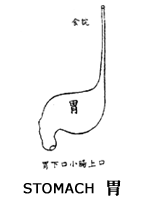 Stomach Stomach
The stomach, known as "the sea of food and fluid", is responsible for "receiving" and "ripening" ingested food and fluids. When food is ingested, it passes down into the stomach where stomach qi and fluid decompose it into materials to be further digested in the small intestine.
Food is divided into two parts in the stomach. The "pure" part is sent upwards to the spleen for transformation into nutrient materials for the body. The "impure" part is sent downwards to the small intestine. This function is called the "descending the impure" in TCM. While the spleen rules "ascending" functions, the stomach rules "descending" functions. If the stomach loses its descending properties, disharmony occurs, leading to symptoms such as nausea and vomiting. Being a yang organ, the stomach prefers a moist rather than dry environment. Excess of yang may sometimes cause "dryness fire" which leads to stomach disharmony as well. This condition presents as a dry mouth and thirst.
Click here to read more about the Stomach Meridian.
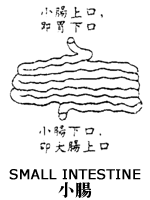 Small intestine Small intestine
The small intestine rules "containing and transforming." It receives what the stomach has not completely digested and this material is further digested into nutrients. The small intestine also separates the "pure" from the "impure." Like the stomach, the small intestine sends the "pure" (useful) part to the spleen where the nutrients will be distributed, and the "impure" (waste) part is directed down into the large intestine. Any useless water produced in the digestion process will be sent to the bladder and stored as urine. Healthy small intestine functions are essential for normal urination and defecation. If disharmony is present, an individual may experience dysuria (difficulty or pain on urination) or loose stools.
Click here to read more about the Small Intestine Meridian.
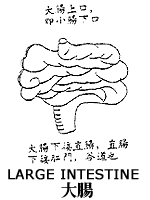 Large intestine Large intestine
The large intestine receives the "impure" parts of the digested food from the small intestine and continues to absorb water from these materials. At the end of the process, stools are formed and excreted through the anus. Large intestine disharmony presents with symptoms of abdominal pain, intestinal rumblings and diarrhea. Sometimes, if there is excessive "heat", intestinal fluids will dry up, and constipation will occur.
Click here to read more about the Large Intestine Meridian.
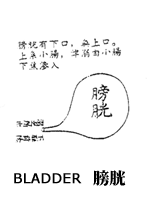 Bladder Bladder
The bladder is responsible for storing and excreting urine. As previously discussed, the lungs, spleen and kidneys all have roles in fluid metabolism and regulating the water distribution in the body. The "turbid' water collected by the kidneys that cannot be reused by the body is sent to the bladder for excretion as urine. TCM describes this function as "vaporization" of urine in the bladder. Disharmony of the bladder can lead to urinary problems such as incontinence or difficult urination. Kidney function complements bladder function so a problem with the bladder often indicates kidney problems as well.
Click here to read more about the Bladder Meridian.
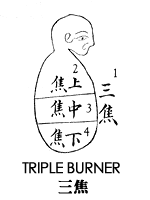 Triple Burner Triple Burner
The triple burner is a special concept in TCM, and there is no corresponding organ in western medicine. Suggestions have been made that the triple burner's function may be related to the pancreas and metabolism in the body, but no clear conclusion has been reached as to the nature of this organ. The triple burner is actually a collective term for the upper, middle and lower burner. The Chinese word "triple burner" actually means "three parts which burn or scorch."
The upper burner is located above the diaphragm and includes the heart and lungs. The middle burner is located in the region above the belly button and below the diaphragm and includes the spleen and stomach. The lower burner is located below the belly button, and it includes the liver, kidneys, large intestine, small intestine and bladder. (This description of location is used for the functional classification of the TCM triple burner. The above locations do not refer to the anatomical location of organs.)
The triple burner's functions relate to the activities of qi and the movement of water. The functions of the three burners were summarized in the Huang Di Nei Jing (The Yellow Emperor's Classic of Internal Medicine) as follows: "The upper burner acts like a mist. The middle burner acts like foam. The lower burner acts like a swamp."
"Mist" refers to the disseminating functions of the upper burner. With this function, qi, blood and body fluids are distributed throughout the body just as mist disperses in the environment. "Foam" means the digestive churning of the middle burner. When the spleen and stomach transform and ripen food, the food decomposes in a similar way to foaming. "Swamp" relates to the excretion of impure substances. The lower burner separates the "clear" from the "turbid" substances and excretes these impurities as wastes- like a swamp breaks down certain vegetation.
The triple burner is the passage through which water, food and fluid are transported. The Huang Di Nei Jing (The Yellow Emperor's Classic of Internal Medicine) also says, "The triple burner is the controller of the entire circulation of body fluid". Therefore, disharmony of the triple burner can lead to edema ( fluid collection in the tissues) or difficult urination. Treatment of these conditions is aimed at resuming the harmony of the affected organs such as the lungs, spleen or kidneys.
Click here to read more about the Triple Burner Meridian.
References:
1. 張恩勤:《中醫基礎理論》〈上冊〉,上海 上海中醫藥大學出版社,1990。
2. 劉家義等:《中醫診斷學》,上海 上海中醫藥大學出版社,1990。
3. 北京中醫學院:《中醫學基礎》〈第一版〉,上海 上海科學技術出版社,1978。
4. 印會河:《中醫基礎理論》,上海 上海科學技術出版社,1985。
5. 《黃帝內經素問》,北京 人民衛生出版社,1978。
6. 劉燕池:《中醫基礎理論問答》〈第一版〉,上海 上海科學技術出版社,1982。
7. Kaptchuk Ted J., Chinese Medicine :The Web That Has No Weaver, London: Rider, (2000).
8. Williams Tom, Complete Chinese Medicine, Bath: Mustard, (1999).
9. Stedman's Medical Dictionary, 27th Ed., Lippincott Williams & Wilkins, (2000)
Written By:
Dang Yi
Professor, Beijing University of Chinese Medicine
Ph.D. Beijing Union Medical College
Vice Director, Gourmet Food Institute of Health Care and Nutrition of Beijing
Edited By:
Angelo Chung, B Pharm., Integrated Chinese Medicine Holdings Ltd.
Angela Collingwood, MSN, Integrated Chinese Medicine Holdings Ltd.
Margaret Harris, MD, Integrated Chinese Medicine Holdings Ltd.
Translated By:
Michael Yang |